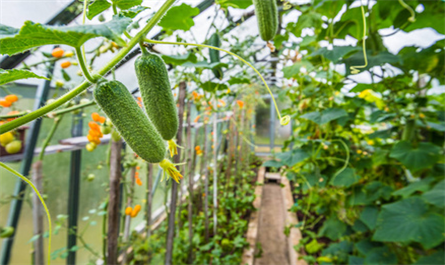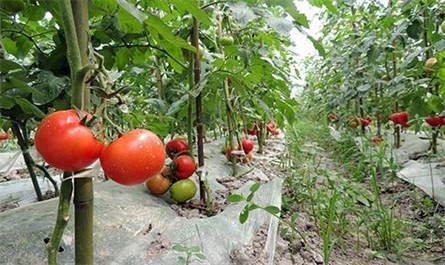What are the applications of plant growth regulators on vegetables?
Application of plant growth regulators on vegetables:
1. Application of Ethephon on Cucumber
Spraying ethephon at a concentration of 100-200 parts per million at the 1-3 leaf stage of cucumber seedlings can increase the number of female cucumber flowers. If necessary, spray again after 1 week;

2. Application of Paclobutrazol on Watermelon
Spray the entire watermelon plant with paclobutrazol at a concentration of 200-500 parts per million, 10 days apart, and spray 2-3 times continuously to increase the fruit setting rate;
0.2 parts per million 2,4-D sprays the entire female flower organ to promote fruit setting.
When the concentration of the liquid exceeds 25 parts per million, phytotoxicity will occur.
3. Application of 4-D on Zucchini
Apply 20-30 parts per million of 2,4-D around the base of the open female flower style of zucchini to promote fruit setting. Be careful not to reapply.
4. Application of Ethephon on Pumpkin
100-200 parts per million of ethephon is sprayed on the foliage of the seedlings at the 1-2 true leaf stage to promote the differentiation of female flowers, resultingripe early and increase production of more than 30%.
5. Application of Chlorocholine chloride on Tomato
irrigating 100-150 ml of chlorocholine chloride per plant with about 50 parts per million can make the tomato plants dwarfed, the main stems strong and the root system developed, thereby promoting tomato budding, flowering and fruiting. and can enhance stress resistance; soak flowers with 10-25 parts per million (decrease and increase with temperature)
2, 4-D liquid, once every 2-3 days, you can soak flowers that will bloom quickly and flowers that have already bloomed.
However, be careful not to soak the tomatoes repeatedly or use them on tomatoes that have been grow seed;
soaking the picked tomatoes that have turned color with 2000 parts per million of ethephon can make the tomatoes turn red in advance.
The soaking time should be within 10 seconds, and then take them out.
Drip the medicine overnight, stack it in the hotbed and keep it ventilated.

6. Application of cytokinin on Eggplant
Soaking eggplant seeds in 6000 times of cytokinin for 8-12 hours and then sowing them can promote the growth of eggplant seedlings; soaking flowers in 2,4-D solution of 20-50 parts per million (decreases and increases with the temperature), 2-3 Once a day, preferably 1-2 days before flowering, soak the flowers one by one in the medicine. However, be careful not to dip it repeatedly and do not use it on eggplants that have been seeded.
7. Application of 6-BA on Lettuce
Soaking lettuce seeds with 100 parts per million of 6-BA for 3 minutes can increase the germination rate of lettuce seeds by 67%; 2500 parts per million of cyanin can significantly inhibit the growth of lettuce stems when sprayed 2-3 times. Bolting and flowering promote stem thickening and increase production
8. Application of gibberellin on Celery
Spraying the whole plant with 20-50 parts per million of gibberellin about 15 days before harvesting celery twice at intervals of 7 days, can increase the production by more than 20%; dissolve 2 grams of brassinolide in 0.2 liters of warm water and then mix it with cold water for 15 seconds -20 liters, mix well, and spray during the seedling and growth stages of celery to speed up the growth of celery, make the plants tender, have soft fibers, and increase production.
9. Application of paclobutrazol on Carrot
100-150 parts per million of paclobutrazol spraying on the radish leaves after sealing the field. The dosage of 30-40 liters per acre can inhibit the growth of radish, promote photosynthesis, and increase production by 10-20%;
2 grams Dissolve brassinolide in 0.2 liters of warm water, mix with 15-20 liters of cold water, mix well, and spray it during the rosette stage of radish, which can increase production by 15-50%.
(Note: One part per million is basically equivalent to 1 mg/L or 1 g/ton)
1. Application of Ethephon on Cucumber
Spraying ethephon at a concentration of 100-200 parts per million at the 1-3 leaf stage of cucumber seedlings can increase the number of female cucumber flowers. If necessary, spray again after 1 week;

2. Application of Paclobutrazol on Watermelon
Spray the entire watermelon plant with paclobutrazol at a concentration of 200-500 parts per million, 10 days apart, and spray 2-3 times continuously to increase the fruit setting rate;
0.2 parts per million 2,4-D sprays the entire female flower organ to promote fruit setting.
When the concentration of the liquid exceeds 25 parts per million, phytotoxicity will occur.
3. Application of 4-D on Zucchini
Apply 20-30 parts per million of 2,4-D around the base of the open female flower style of zucchini to promote fruit setting. Be careful not to reapply.
4. Application of Ethephon on Pumpkin
100-200 parts per million of ethephon is sprayed on the foliage of the seedlings at the 1-2 true leaf stage to promote the differentiation of female flowers, resultingripe early and increase production of more than 30%.
5. Application of Chlorocholine chloride on Tomato
irrigating 100-150 ml of chlorocholine chloride per plant with about 50 parts per million can make the tomato plants dwarfed, the main stems strong and the root system developed, thereby promoting tomato budding, flowering and fruiting. and can enhance stress resistance; soak flowers with 10-25 parts per million (decrease and increase with temperature)
2, 4-D liquid, once every 2-3 days, you can soak flowers that will bloom quickly and flowers that have already bloomed.
However, be careful not to soak the tomatoes repeatedly or use them on tomatoes that have been grow seed;
soaking the picked tomatoes that have turned color with 2000 parts per million of ethephon can make the tomatoes turn red in advance.
The soaking time should be within 10 seconds, and then take them out.
Drip the medicine overnight, stack it in the hotbed and keep it ventilated.

6. Application of cytokinin on Eggplant
Soaking eggplant seeds in 6000 times of cytokinin for 8-12 hours and then sowing them can promote the growth of eggplant seedlings; soaking flowers in 2,4-D solution of 20-50 parts per million (decreases and increases with the temperature), 2-3 Once a day, preferably 1-2 days before flowering, soak the flowers one by one in the medicine. However, be careful not to dip it repeatedly and do not use it on eggplants that have been seeded.
7. Application of 6-BA on Lettuce
Soaking lettuce seeds with 100 parts per million of 6-BA for 3 minutes can increase the germination rate of lettuce seeds by 67%; 2500 parts per million of cyanin can significantly inhibit the growth of lettuce stems when sprayed 2-3 times. Bolting and flowering promote stem thickening and increase production
8. Application of gibberellin on Celery
Spraying the whole plant with 20-50 parts per million of gibberellin about 15 days before harvesting celery twice at intervals of 7 days, can increase the production by more than 20%; dissolve 2 grams of brassinolide in 0.2 liters of warm water and then mix it with cold water for 15 seconds -20 liters, mix well, and spray during the seedling and growth stages of celery to speed up the growth of celery, make the plants tender, have soft fibers, and increase production.
9. Application of paclobutrazol on Carrot
100-150 parts per million of paclobutrazol spraying on the radish leaves after sealing the field. The dosage of 30-40 liters per acre can inhibit the growth of radish, promote photosynthesis, and increase production by 10-20%;
2 grams Dissolve brassinolide in 0.2 liters of warm water, mix with 15-20 liters of cold water, mix well, and spray it during the rosette stage of radish, which can increase production by 15-50%.
(Note: One part per million is basically equivalent to 1 mg/L or 1 g/ton)
RECENT POSTS
-
Using Plant Growth Regulators to Improve Celery Yield and Quality
-
How to correctly use plant growth regulators in vegetable production?
-
Application Effects and Methods of Prohexadione Calcium in Garlic Cultivation
-
DA-6 application methods for potatoes sweet potatoes and ginger during their tuber expansion phase
Featured News



